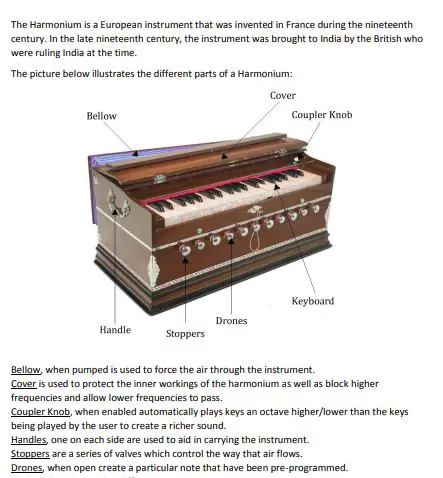‘Harmonium Scale Chart’ PDF Quick download link is given at the bottom of this article. You can see the PDF demo, size of the PDF, page numbers, and direct download Free PDF of ‘Harmonium Raag Notation’ using the download button.
Harmonium Notation Scale Chart PDF Free Download

Harmonium Basic
The Harmonium is a European instrument that was invented in France during the nineteenth century.
In the late nineteenth century, the instrument was brought to India by the British who were ruling India at the time.
The picture below illustrates the different parts of a Harmonium:
Bellow, when the pump is used to force the air through the instrument.
The cover is used to protect the inner workings of the harmonium as well as block higher frequencies and allow lower frequencies to pass.
Coupler Knob, when enabled automatically plays keys an octave higher/lower than the keys being played by the user to create a richer sound.
Handles, one on each side are used to aid in carrying the instrument. Stoppers are a series of valves that control the way that air flows. Drones, when open create a particular note that has been pre-programmed.
The keyboard is used to play different notes. Open only one clip on the side of the bellow (pump).
If you are right-handed, you should pump with your left hand and play with your right hand. If you are left-handed, you should pump with your right hand and play with your left hand.
Place your fingers on the keys before you start pumping. Do not unnecessarily bang on the keys with your fingers or other objects.
Do not open the cover on the top of the Harmonium to expose the mechanism/reeds.
Make sure that the appropriate drone/stoppers are in the open position before playing and pumping.
Make sure to close the drones/stoppers and place the cover back on the Harmonium after you are done playing.
If you see a child playing around with a Harmonium, notify an adult immediately.
As noted earlier, the use of the word ‘scale’ in measurement theory is closely related to its use in music; in particular, this use of ‘scale’ derives from the Latin word sc³lae [ladder].
In this section, we examine musical scales from the viewpoint of measurement theory (and of course music theory). As we will see, from the viewpoint of measurement theory, a musical scale is basically an interval scale;
indeed, in music theory, the distances between notes are even called ‘intervals’! The question then is – how are these intervals measured?
Music is based on pitch.
For example, when a guitar string is plucked, it vibrates, thereby producing sound with a characteristic fundamental frequency, which we perceive as pitch or tone.
Pitch recognition is part of the human sensory endowment; we innately recognize when frequency/pitch goes up, and when it goes down.
The evolution of this ability is most likely associated with communication, which played a vital role in the development of modern humans.
Pitch production and recognition allow for more subtle and varied communication.
This shows up in modern languages, in which pitch distinctions are crucial for conveying grammatical (and even lexical2 ) information.
For example, the question “You did ?” is intonated quite differently from the statement “You did”; this tonal distinction would be impossible without our ability to produce and hear a pitch.
Singing basically involves producing sequences of syllable tones. Some sequences seem more agreeable than others, and some combinations of pitches seem more harmonious than others.
This is partly cultural, and it is partly psycho-physical.
In any case, over the course of history, by way of organizing pitch combinations, various human cultures have devised various musical scales.
It is quite difficult to give a simple definition of the musical scale, but it is extremely simple to give
an example.
In the Western world, probably the best-known (and most widely used) musical scale is the major scale do re mi fa so la ti do which virtually everyone can recite, and which is immortalized in a song from the movie “Sound of Music”.
What is crucial to realize in describing the major scale is that the scale values (do, re, …) do not correspond to particular pitches; for example, do does not correspond to a frequency of 400 Hz,4, or any other frequency.
In other words, a musical scale does not correspond to a conventional ratio scale, like weight or volume.
On the other hand, a musical scale is more than an ordinal scale; there is more to a musical scale than the order of the pitches, low to high.
Rather, a major scale is a special kind of interval scale – one defined by the pitch relations (intervals) among the various scale values.
In addition to the major scale, there have been thousands of other scales that have been
theoretically proposed and studied, and there have been hundreds of scales that have been actually used by people to produce music.
What further complicates the study of musical scales is that the major scale is not a singular object, since there are different ways of calibrating its different components.
In what follows, first, we examine the various ways in which the major scale can be calibrated (i.e., tuned), and second, we examine a few alternative musical scales, both theoretical and practical.
| Author | – |
| Language | English |
| No. of Pages | 6 |
| PDF Size | 2 MB |
| Category | Music |
| Source/Credits | tampagurdwara.com |
Related PDFs
Guitar Chords For Dummies Beginners PDF
Harmonium Scale Chart PDF Free Download
